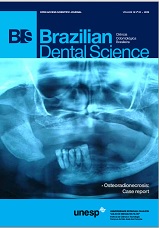A comparative study of biaxial flexural strength and Vickers microhardness of different zirconia materials: Effect of glazing and thermal cycling
DOI:
https://doi.org/10.14295/bds.2015.v18i2.1109Abstract
Objective:This study evaluated the effect of glazing and thermal cycling on biaxial flexural strength and Vickers hardness of different zirconia core materials. Material and Methods: Disc shaped zirconia specimens (15 mm x 1.15 mm) were fabricated out of three systems (ZirkonZahn, Cercon, Ceramill) according to each manufacturer`s instructions. The specimens of each system were randomly divided into initially 2 groups. While half of the specimens were glazed, the other half was left unglazed. Each group was further divided into 4 subgroups to be subjected to thermal cycling (0-control, 1000, 3000, 5000 cycles, 5-55 ºC). Biaxial flexural strength was tested in a universal testing machine (1 mm/min). Another set of unglazed zirconia specimens were made and tested for Vickers microhardness with and without thermocycling (0-control, 1000, 3000, 5000 cycles, 5-55 ºC). Data were statistically analyzed using one-way ANOVA, two-way ANOVA and Tukey’s test (p < 0.05). Results: In non-aged conditions (11034-1388 MPa), glazing significantly decreased the biaxial flexural strength of all zirconia ceramics (845.65-897.35 MPa) (p = 0.000). While in the non-glazed groups, all thermal cycling regimens significantly decreased the biaxial flexural strength (864-1156 MPa) (p=0.000), in glazed groups thermal cycling did not affect the results (829.4-854.9 MPa) (p = 0.405). Compared to the non-aged group (1414.1 VHN), thermal cycling decreased the Vickers hardness significantly only for Cercon (1365.9 VHN) (p = 0.005). Conclusion: Glazing decreased the biaxial flexural strength of the zirconia ceramics tested. Unglazed zirconia ceramics were weaker against thermal cycling compared to glazed ones. For monolithic zirconia restorations, this information may have clinical importance.
Keywords:Biaxial flexural strength; Glazing; Thermal cycling; Vickers microhardness; Zirconia.
Downloads
Downloads
Published
How to Cite
Issue
Section
License
Brazilian Dental Science uses the Creative Commons (CC-BY 4.0) license, thus preserving the integrity of articles in an open access environment. The journal allows the author to retain publishing rights without restrictions.
=================




























